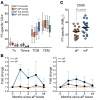Th1/Th17 polarization persists following whole-cell pertussis vaccination despite repeated acellular boosters
- PMID: 29920186
- PMCID: PMC6118631
- DOI: 10.1172/JCI121309
Th1/Th17 polarization persists following whole-cell pertussis vaccination despite repeated acellular boosters
Abstract
In the mid-1990s, whole-cell pertussis (wP) vaccines were associated with local and systemic adverse events that prompted their replacement with acellular pertussis (aP) vaccines in many high-income countries. In the past decade, rates of pertussis disease have increased in children receiving only aP vaccines. We compared the immune responses to aP boosters in individuals who received their initial doses with either wP or aP vaccines using activation-induced marker (AIM) assays. Specifically, we examined pertussis-specific memory CD4+ T cell responses ex vivo, highlighting a type 2/Th2 versus type 1/Th1 and Th17 differential polarization as a function of childhood vaccination. Remarkably, after a contemporary aP booster, cells from donors originally primed with aP were (a) associated with increased IL-4, IL-5, IL-13, IL-9, and TGF-β and decreased IFN-γ and IL-17 production, (b) defective in their ex vivo capacity to expand memory cells, and (c) less capable of proliferating in vitro. These differences appeared to be T cell specific, since equivalent increases of antibody titers and plasmablasts after aP boost were seen in both groups. In conclusion, our data suggest that there are long-lasting effects and differences in polarization and proliferation of T cell responses in adults originally vaccinated with aP compared with those that initially received wP, despite repeated acellular boosters.
Keywords: Adaptive immunity; Cellular immune response; Immunology; Th1 response; Vaccines.
Conflict of interest statement
Figures









Comment in
-
Composition of pertussis vaccine given to infants determines long-term T cell polarization.J Clin Invest. 2018 Aug 31;128(9):3742-3744. doi: 10.1172/JCI122726. Epub 2018 Aug 6. J Clin Invest. 2018. PMID: 30080178 Free PMC article.
Similar articles
-
Acellular pertussis booster in adolescents induces Th1 and memory CD8+ T cell immune response.PLoS One. 2011 Mar 8;6(3):e17271. doi: 10.1371/journal.pone.0017271. PLoS One. 2011. PMID: 21408149 Free PMC article. Clinical Trial.
-
T-cell responses before and after the fifth consecutive acellular pertussis vaccination in 4-year-old Dutch children.Clin Vaccine Immunol. 2012 Nov;19(11):1879-86. doi: 10.1128/CVI.00277-12. Epub 2012 Sep 26. Clin Vaccine Immunol. 2012. PMID: 23015649 Free PMC article.
-
Differential T- and B-cell responses to pertussis in acellular vaccine-primed versus whole-cell vaccine-primed children 2 years after preschool acellular booster vaccination.Clin Vaccine Immunol. 2013 Sep;20(9):1388-95. doi: 10.1128/CVI.00270-13. Epub 2013 Jul 3. Clin Vaccine Immunol. 2013. PMID: 23825195 Free PMC article.
-
Pertussis vaccines and protective immunity.Curr Opin Immunol. 2019 Aug;59:72-78. doi: 10.1016/j.coi.2019.03.006. Epub 2019 May 9. Curr Opin Immunol. 2019. PMID: 31078081 Free PMC article. Review.
-
Pertussis vaccines and the challenge of inducing durable immunity.Curr Opin Immunol. 2015 Aug;35:48-54. doi: 10.1016/j.coi.2015.05.008. Epub 2015 Jun 17. Curr Opin Immunol. 2015. PMID: 26091979 Review.
Cited by
-
Bordetella pertussis and outer membrane vesicles.Pathog Glob Health. 2023 Jun;117(4):342-355. doi: 10.1080/20477724.2022.2117937. Epub 2022 Sep 1. Pathog Glob Health. 2023. PMID: 36047634 Free PMC article. Review.
-
Toward a Controlled Human Infection Model of Pertussis.Clin Infect Dis. 2020 Jul 11;71(2):412-414. doi: 10.1093/cid/ciz842. Clin Infect Dis. 2020. PMID: 31552410 Free PMC article. No abstract available.
-
How immunology can help reverse the pertussis vaccine failure.Nat Immunol. 2023 Nov;24(11):1779-1780. doi: 10.1038/s41590-023-01625-8. Nat Immunol. 2023. PMID: 37783797 No abstract available.
-
Disrupting Bordetella Immunosuppression Reveals a Role for Eosinophils in Coordinating the Adaptive Immune Response in the Respiratory Tract.Microorganisms. 2020 Nov 17;8(11):1808. doi: 10.3390/microorganisms8111808. Microorganisms. 2020. PMID: 33212993 Free PMC article.
-
B cells modulate mouse allergen-specific T cells in nonallergic laboratory animal-care workers.JCI Insight. 2021 Feb 22;6(4):e145199. doi: 10.1172/jci.insight.145199. JCI Insight. 2021. PMID: 33616085 Free PMC article.
References
-
- Epidemiology and Prevention of Vaccine-Preventable Diseases. CDC Website. https://www.cdc.gov/vaccines/pubs/pinkbook/pert.html Accessed June 22, 2018.
Publication types
MeSH terms
Substances
Grants and funding
LinkOut - more resources
Full Text Sources
Other Literature Sources
Molecular Biology Databases
Research Materials
Miscellaneous

